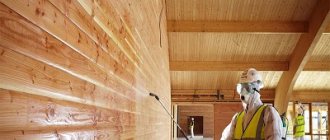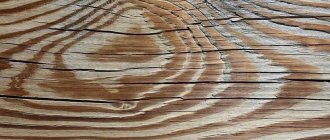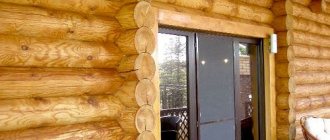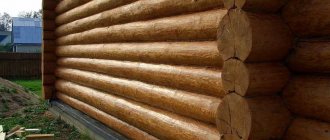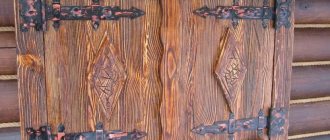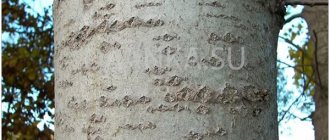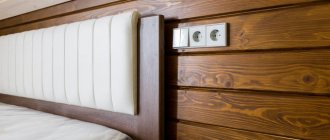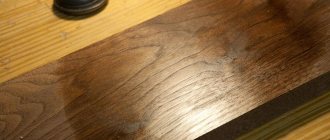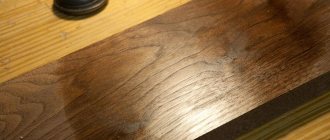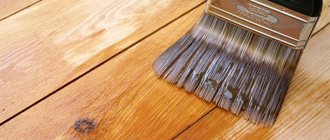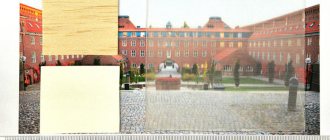Wood unprotected by special means is destroyed over time by fungus, mold, insects and moisture. Treatment of the log house from rotting and parasites is carried out with various antiseptics, available in a large assortment at any hardware store. Impregnation is carried out both at the initial stage and after the construction of the house. Timely identification of problem areas during the operation of a log structure and the elimination of foci of infection discovered during inspection significantly increase the trouble-free service life of the log structure.
Wood protection using folk remedies. Historical excursion
Wood occupies a leading position in the construction market. Its characteristics and abilities have been tested over the years. It is used both for the construction of buildings and for various finishing works.
But in turn, wood is inferior to its competitors (stone, plastic, metal) due to its low resistance to biological agents. Insects, mold, and fungi can cause significant harm to the material, its appearance and strength.
You can protect wood from the effects of biological agents and extend its service life by treating it with folk protective agents.
Protecting wood with copper sulfate
This method of wood processing is the most affordable and widespread. Copper sulfate prevents the formation of rotting of the material for a long time. Mixing with its juice, it prevents the action of moisture on wood, which is the main cause of its decay. This product changes the shade of the wooden material, which needs to be taken into account.
But there are also disadvantages to using copper sulfate; it is unsafe. When heated, it releases toxic substances. And when working with the composition, you need to use gloves to prevent it from coming into contact with the skin, as it irritates it.
Protecting wood with oil
Wooden materials have been treated with oil since ancient times. For this they used mainly linseed oil; it protected the wood and strengthened its structure. The treated wood material had good adhesion. You can apply the oil using a brush or spray. But it takes a very long time to dry, and wood processing must be done in at least 3 layers.
You can also use teak or tung wood oil to protect the wooden material; they can provide greater strength and absorb faster. It is better to process wood using hot oils, because...
in this state they penetrate much deeper into the structure of the wood, thereby protecting it better. In general, it is difficult to call oil or drying oil a folk protective agent.
After all, the production of paints and varnishes occurs with the addition of oils.
Riveting the ends of wood
Much more water penetrates through the ends of the wood, through their capillaries (running along the entire tree trunk). To prevent this, they used to “rivet the ends” by hitting the ends with a wooden or rubber hammer. Thereby destroying the capillaries and preventing moisture from getting inside.
This method of protection also provided strength to the ends and prevented them from cracking. Additionally, they were burned using a blowtorch. In this case, the charred ends also acquired bactericidal properties, preventing the appearance of biological pests.
Finnish wood material protection technology
Preparation of the protective composition:
- Dilute 700g of wheat flour in 9 liters of water. The result should be a mass similar in consistency to sour cream.
- Then stirring gradually add 1500 gr. iron sulfate, 1500 gr. slaked lime and 400 gr. table salt.
The wood must be treated with the warm mixture obtained. It should be applied in several layers, after the previous one has completely dried. This rot-proof technology can be used for wooden fences.
Swedish wood protection technology
To make a protective Swedish product you need:
- Make a paste from 6 liters of water and 1 kg of flour by boiling the composition.
- Then gradually add 0.5 kg of salt, lime coloring pigment, iron sulfate, natural drying oil to the resulting paste and pour in 3 liters of hot water.
The prepared composition must be used immediately to carry out protective treatment of wooden material.
Protecting wood with birch tar
To provide a high degree of protection to wooden material from insects and rot, you can treat it with birch tar or spruce resin. These compounds have a strong odor, they are soiled and sticky, which makes working with them difficult.
Wood treated with tar cannot be subsequently painted, sanded or subjected to other mechanical impacts. In addition, wood with this resinous composition applied to it is easily flammable.
Therefore, treated wood can only be used in underground parts of the building structure.
Protecting wood with used motor oil
This is the most common and inexpensive, one might even say free, method of providing protection to wooden material. It is used mainly in rural areas for processing non-residential wooden structures.
Waste oil consists of 90% mineral oil, which is a good water-repellent and antiseptic agent. It also contains a lot of soot, which protects the wood from the destructive effects of ultraviolet rays.
And a small part of acid salts that eliminate any type of fungus existing in the wooden material.
The working material is applied in a heated state to the surface of the material several times. Particular attention is paid to the ends and crevices of the wood.
If the treated log is dug into the ground, then for efficiency, a little oil is added to the hole itself, and after the post is buried, the mining is poured around it.
The disadvantage of using waste is its soiling and unpleasant dark tint.
Protecting wood with tar
Tar or bitumen is still used to prevent rotting of wooden materials. This method of protection is common for wood of underground structures or for the lower crowns of a log house, which experience adverse effects from the environment to a greater extent.
Before using tar or bitumen, they should be heated and mixed in diesel fuel. Then coat wooden materials with the resulting composition. This method is an effective protective method, but not entirely environmentally friendly. Although now they produce mastics and impregnations with the addition of bitumen.
Protecting wood with a mixture of propolis and sunflower oil
To prepare a protective mixture, you need to take 3 parts sunflower oil and 1 part propolis. Mix everything and apply to dry, cleaned wood using a sponge. Wooden material must be well impregnated. This method of protection against the formation of rot and microorganisms is effective. But you need to keep in mind that wood soaked in this mixture will quickly ignite.
These are the main folk methods of treating wooden material from rotting and the occurrence of biological pests.
They consist mainly in protecting wood from water, which leads to the formation of rot and other unpleasant consequences, and in extending the durability of the entire structure.
Folk remedies have many advantages over the use of synthetic compounds. Processing methods using them are much cheaper, almost all of them are harmless and hypoallergenic for humans.
But folk remedies are not able to cope with more serious enemies of wood, such as white house mushroom. This pest can completely destroy an oak floor in a month. It spreads quickly and infects healthy wood materials.
Therefore, earlier they could not destroy it and burned entire houses in order to save the rest of the nearby wooden buildings. In such severe cases, it is better to use modern antiseptics and impregnations that are effective and available on the construction market.
What should you choose and what is better to buy?
In modern times, in terms of efficiency and good quality of processing of wooden structures, it is best to choose and buy factory-produced wood protection products.
Factory production of antiseptic compounds will protect the wood of your wooden house or bathhouse from rotting and destruction caused by wood pests much better than folk remedies.
High-quality protective compounds include antiseptics, impregnations and paints from NEOMID and PROSEPT.
NEOMID impregnations and antiseptics have good protective characteristics against biological pests of wood.
PROSEPT impregnations and antiseptics have excellent characteristics against biological pests of wooden structures.
How to get advice and consultation and buy a good means of protection?
You can get professional advice on these antiseptic compounds from the honored worker in the field of wood protection from pests: Galina Nikolaevna Zelentsova by phone: +7 (905) 752-77-20.
If you have made a choice in favor of protective equipment of the Neomid, Pirilax, Prosept or other brands, then you can buy them at retail , pick up from the city of Balashikha - here: Contacts.
place a small wholesale order of effective wood protection products with delivery by calling; ;.
Thematic VIDEO:
Modern methods of combating rotting
The development of mold fungi is the main factor that destroys wood. Mold development (rotting) occurs under certain conditions:
- air humidity 80–100%;
- material humidity above 15%;
- temperature below 50 and above 0 C
Additional reasons for rotting may include freezing of the material, stagnation of air, and contact with the soil.
Factors favorable to the decay process are quite common. Therefore, you need to know how to treat wood to protect it from mold.
There are two ways to reliably protect wood: conservation and antiseptic treatment.
When preserving, a product with a long-lasting toxic effect is applied to the timber or board. To do this, the wood is soaked in cold or hot baths, or the preservative penetrates into it using diffusion or autoclave impregnation. The method is applicable only in factory conditions.
Antiseptic treatment involves self-impregnation of the material by applying chemicals with a spray bottle or roller. The antiseptic agent must be selected in accordance with the operating conditions of the wooden structure. For example, impregnations based on water and white spirit are safe and inexpensive, but are easily washed off. Therefore, only water-repellent antiseptics are suitable for elements in contact with moisture or soil.
When choosing a product to treat timber, it is worth understanding the main categories and types of protective compounds. There are three categories of compositions for protecting wood: paints, varnishes, and antiseptics.
We invite you to familiarize yourself with a table for a bathhouse with your own hands (drawings for making it from wood)
Paints perform both protective and aesthetic functions. For interior work it is better to choose water-soluble paints, and for exterior paints - based on an organic solvent.
Varnishes form a protective film on the surface without changing its appearance. For exterior work, varnishes with fungicides are used that kill mold and prevent cracking and fading of wood.
Antiseptics work great when mold has already infected the tree. There are 5 types of them:
- Water soluble. Odorless, non-toxic, dry quickly. They are made on the basis of fluorides, silicofluorides, a mixture of boric acid, borax or zinc chloride. Not recommended for treating surfaces frequently in contact with moisture.
- Water repellent. They are distinguished by deeper penetration into the tree. Suitable for processing bath structures, cellars and basements.
- On organic solvents. Allowed for use in external and internal work. Forms a thick film that dries up to 12 hours.
- Oily. They form a thick, durable coating that is insoluble in water. However, they should only be used with dry wood. When applied to damp wood, oil antiseptics do not prevent the proliferation of fungal spores inside the material.
- Combined. Suitable for any wood and additionally have anti-flammable properties.
The structure of the wood resembles a bundle of thin tubes - capillaries along the trunk. These capillary fibers consist of the base of wood - fiber (cellulose). Over time, fiber tends to break down into poly- and disaccharides, alcohols, aldehydes and organic acids under the influence of enzymes.
In addition to fiber, coniferous (and to a lesser extent deciduous) species contain lignin, an organic substance similar to phenol. And phenolic resins are good bactericidal substances. In order for wood to be resistant to harmful bacteria, lignin is needed in its composition! The removal of lignin from wood is the cause of wood rot and destruction.
The enzymes of saprophytic fungi (tinder fungi, honey fungus and oyster mushrooms), as well as a small number of putrefactive fungi and bacteria, destroy lignin especially well. Insects such as ants, woodworms and some worms “cohabitate” with harmful fungi and bacteria. They crush wood fibers mechanically and promote active fermentation of cellulose and destruction of lignin. Such processes proceed especially well at high humidity.
The most terrible enemy of a tree is the white house mushroom. Sometimes it resembles ordinary mold, which makes it impossible to correctly determine the cause of wood damage. Under certain conditions, it can “eat up” an oak floor in just one month! Therefore, in the old days, houses affected by this fungus were burned. to protect other wooden buildings.
Antiseptics and impregnations based on modern achievements of biochemists are not a folk remedy for protecting and treating wood, but they are the most effective and affordable on the building materials market.
Lime as an antiseptic for wood?
Wood today, as before, is considered one of the most durable and environmentally friendly materials, which is widely used in construction and repair work. Due to its decorative effect, many people want to decorate surfaces with it.
Wood is one of the most durable and environmentally friendly materials, which is widely used in construction and repair work.
But, as a rule, wood is considered a living material, and therefore requires mandatory processing that will prevent rotting and damage to the surface. Today there are two types of wood treatment against rotting: folk and synthetic.
Wood processing using traditional methods
Let's start with processing with folk remedies. Such methods have many advantages over synthetic compounds.
Firstly, such treatment costs much less, and secondly, absolutely all folk remedies are environmentally harmless and hypoallergenic, which is very important for human health.
Now let's look in more detail at several of the most effective methods of treating wood against rotting:
Copper sulfate heals and disinfects cracks in the roots of branches and trunks.
- Wood processing using a mixture of propolis and regular sunflower oil. To do this, take oil and propolis in a ratio of approximately 3:1. Everything is thoroughly mixed and applied to dry wood that has been previously cleaned of dust using a soft sponge. It is necessary to thoroughly saturate the wood with this composition. The good thing about this method is that it is the strongest in protecting against rot and microorganisms. But there is a big drawback in this method. Impregnated wood will ignite very quickly. Therefore, learn this and think about whether it is advisable to use this impregnation in your particular case.
- Impregnation with copper sulfate solution. For this purpose, a ready-made solution of copper sulfate is purchased and mixed thoroughly. After this, a soft sponge or cloth is dipped into it, and clean, dry wood is impregnated with it. This is an ideal option for a round log, since in material terms it is not too expensive, and its efficiency is high. With fairly strong impregnation, the wood will last a long time without causing any inconvenience. The only negative is the drying time. The wood impregnated in this way must be thoroughly dried in the open air, but so that the sun's rays do not fall on it. It is advisable to make a canopy specifically for this purpose. The wood can dry from a week to a month - the longer the better.
- Another option is to use hot bitumen on wood. This is a very good method in terms of efficiency, but from an environmental point of view it is not completely safe. After all, as you know, bitumen tends to release some harmful substances when heated. Therefore, it is not always recommended to use it.
- Automotive oil is also not a completely pure environmental material, but is widely used for wood processing. Oil perfectly protects against mold, rot and bark beetles, but will not prevent fire, but will make it even faster and stronger. Therefore, it is not always possible to use this remedy.
Automotive oil provides excellent protection against mold, rot and bark beetles.
A separate method of wood processing is processing using the Finnish method. It consists of using flour, salt, iron sulfate, water and dry slaked lime. The method is harmless, but most often it is advisable to use it for processing wood for fences and for roofing. The composition is selected in such a way that it lasts a long time and is not quickly washed out with water.
To prepare the mixture, the components are mixed to form a paste in the form of sour cream. Moreover, the main part of it consists of water and flour. Once you have thoroughly mixed everything, heat the mixture over low heat and then apply it to the wood while still warm in two layers. In this case, only after the first layer has completely absorbed and dried is the second layer applied.
So, the main folk methods of treating wood against rotting are considered. But there are also unnatural synthetic products that are also widely used. They are also called construction antiseptics. This is not to say that they are all equally harmful or effective. Therefore, it is advisable to understand them in more detail.
Types of water-soluble antiseptics
Antiseptic agents are best used if the wood has already rotted.
The first type of wood antiseptics is water-soluble antiseptics. They perfectly protect the wood in conditions of constant contact with water, but are also easily washed out. Therefore, periodic processing of wood using such methods is required. These substances are usually classified as:
- Ammonium and sodium silicofluorides. These are odorless white powders that become transparent when in contact with water. Therefore, impregnation with their help must be carried out very carefully so that the compositions completely penetrate all the fibers. Ammonium silicofluoride, in addition to protecting against fungus, also provides the tree with additional fire resistance, which is very important in modern conditions.
- Sodium fluoride is a very strong antiseptic. This is also a white, odorless powder. It is easily washed out with water, so wood treated with this method must undergo such treatments periodically. But this substance has a big advantage: unlike the above-mentioned silicofluorides, this substance does not cause corrosion of metal that may be in wood.
- Various imported substances, based on mixtures such as zinc, chlorine, sodium, potassium, borax and many others. Such mixtures are much more expensive, but protect the tree to a greater extent. But from an environmental point of view, it is not recommended to use them for residential premises, as they can release toxic substances.
In addition to the described groups of antiseptics, it is also customary to distinguish between antiseptics in the form of pastes, oil and organic antiseptics. To better understand them and choose the most suitable substance, let’s consider each of these groups in more detail.
Methods for protecting wood from rotting.
- Treating wood against rotting with pastes. These substances are mixtures of water-soluble antiseptics, silicofluorides and binders. Due to this, resistance to moisture is achieved, which is why pastes are widely used for treating protruding external wooden structures. But even paste tends to wash out over time. It requires less frequent application to wood than fluorides and silicofluorides, but for better protection of wood structures treated with this method, it is recommended to additionally cover them with a special construction waterproofing film.
- The water-soluble group of antiseptics usually includes two main types of solutions: solutions of pentachlorophenol (PL) and solutions of copper neftenade (CNP). Both solutions are lightweight, but have an extremely high degree of toxicity. Antiseptics of the NML type are the most toxic. Because of this, working with them requires special care. Moreover, this type of solution stains the wood green, which can significantly change its appearance. This antiseptic is used only in certain industrial cases. Substances like PL are also very toxic. In their own way, these are even catalysts for oil antiseptics, which are not able to protect wood in all cases. The use of these solutions is advisable when wood must be urgently processed. Again, it is strictly not recommended to use it for domestic purposes.
- And finally, another group - oil-type antiseptics. This generally includes all technical oils. Of course, they are also toxic. But still, as a rule, they have the best antiseptic properties: they are not washed out with water, protect wood from almost all types of fungi for a long time, have a pungent odor and a dark brown color. It is not practical to treat wood against rotting in this way in a residential area. But in structures such as piles, bridge supports, utility poles and other structures that will not subsequently come into contact with humans and do not need decorative decoration, these antiseptics can be safely used.
Folk remedies for protecting wood from rotting and moisture
People have been building wooden houses for thousands of years, and just as many years have been trying to solve the problem of rotting and flammability of wood.
In the wake of the fashion for everything natural, we decided to recall traditional, folk ways of protecting wood from rotting, moisture and insects.
Some of them are still in use, others are gradually becoming a thing of the past, as they are not able to compete with industrially produced protective compounds.
All folk methods of protecting wood can be divided into constructive and processing. Constructive methods involve physical limitation of exposure to adverse factors. Processing methods include coating and impregnation with protective compounds.
Structural protection is measures to limit the effects of moisture on wooden elements. This includes waterproofing the foundation, lower crowns, ends of wooden rafters, and floor beams. To reduce wetting of the walls, the roof overhangs are made at least 50 cm wide. Natural ventilation must be provided: dormers are installed in the attics, and vents are installed in the underground.
The second direction of constructive protection is multi-layer facades. Walls made of timber and logs are sheathed with clapboard, covered with mineral wool and curtain wall facades. Thanks to this, they are not exposed to precipitation and sunlight, which have a destructive effect on wood.
Coatings
Coatings are thick pastes made from natural materials that are used to cover exposed areas of a wooden structure. Coating with clay is the first, but not the only, means of protecting the ends of wood. Resin is used to prevent rotting and insect damage.
lime and even silicate glue. Folk remedies work on healthy or lightly infected wood. They are not effective in treating serious diseases and lesions.
Popular coating recipes
- Clay, salt, water. The ratio of clay and salt is 74:4, water is added until a creamy consistency is obtained.
- Superphosphate and water (70:30).
- Sulfite-alcohol stillage, clay, water (25:50:25).
- Finnish exotic - a composition based on flour, salt, lime and iron sulfate. It protects against rotting and is not washed out with water for a long time.
- Silicate glue.
Most folk recipes for protective pastes contain toxic substances.
They are hazardous to health, so they should be used with great caution and only where constant direct contact with humans or animals is excluded.
Coatings are applied in at least two layers with a thickness of 2-3 mm. It is inconvenient to use them to protect large structures: processing takes a lot of time and money.
Most often, impregnations are made from oils. Oil is used as a means of protecting wood from moisture and rotting. Unfortunately, it increases the flammability of structures, so it is safer to use it in damp places.
- One of the most common methods is impregnation with used oil. The method is suitable only for non-residential premises; it is often used when installing fences. The oil is applied in several layers, preheated.
- Birch tar is an alternative to mining. Typically, tar is used to treat parts of wooden structures that are underground, as it is sticky and has a fairly strong odor. Tar mixed with kerosene or turpentine is considered a good insect repellent. It kills pests instantly.
- For small structures, vegetable oil mixed with wax or propolis is used. It gives the wood a pleasant shine and shade, and has water-repellent qualities.
Wood burning
One of the most common methods of protection against rotting is heating. Bacteria and insects that have already settled in the logs die under the influence of high temperatures.
The wood is burned, destroying the surface layer until it becomes charred using a blowtorch. Coal makes it difficult to absorb moisture and has a bactericidal effect - microorganisms and insects do not develop in it. This method of protection is used for elements that are dug into the ground.
Folk remedies save wood from rotting and insects, but have virtually no effect on its flammability. If comprehensive protection is required, use the latest generation of biopyrenes. NORT compositions protect wooden structures from biological factors and fire, extend the service life of wooden structures.
To get advice on selection, please call +7.
Using drying oil
Protecting wood from moisture and rotting with drying oil can also be done. For this purpose, some varieties of the mentioned composition are used. Among others, semi-natural mixtures should be highlighted, which allow the formation of a hard film with a high level of gloss on the surface. The base becomes water resistant. Semi-natural drying oil is good because it can be used in combination with paints and varnishes or as a primer.
We suggest you familiarize yourself with How to cover the walls in a bathhouse inside
Modifiers are added to combined formulations to improve the quality of the mixture. You can use combined drying oils not only to protect wood, but also as a preparation before applying paint or plaster. When protecting wood from moisture and rotting with your own hands using drying oil, you should not forget that the liquid will dry out within a day or more.
Lime as an antiseptic for wood – All about timber and woodworking
Wood today, as before, is considered one of the most durable and environmentally friendly materials, which is widely used in construction and repair work. Due to its decorative effect, many people want to decorate surfaces with it.
Wood is one of the most durable and environmentally friendly materials, which is widely used in construction and repair work.
But, as a rule, wood is considered a living material, and therefore requires mandatory processing that will prevent rotting and damage to the surface. Today there are two types of wood treatment against rotting: folk and synthetic.
How to impregnate wood to prevent it from rotting
Wood is one of the most common building materials in the world.
It is widely used both for the construction of buildings and for interior decoration, due to its strength, durability and excellent aesthetic characteristics.
Since this is a natural material, it is susceptible to biodegradation under the influence of moisture and microorganisms, so it is important to prevent the putrefactive process. How and what is used to treat wood against rotting?
Recipes for lime-based whitewashing compositions
The garden whitewash mixture contains the following ingredients:
- 2.5 kg of slaked lime (fluff);
- 10 liters of water;
- a few spoons of flour paste.
Instead of paste, you can use other ingredients: clay (1 kg), soap (10 tablespoons of shavings), fresh mullein (0.8-1 kg).
Lime should be taken in lumps and slaked 2 hours before whitewashing. Freshly slaked lime works best in controlling pests, lichens and fungi.
Whitewashing trees with lime and copper sulfate has worked well. To prepare a suitable mixture you should take:
- 2 kg of slaked lime (fluff);
- 300 g of copper sulfate;
- 10 liters of water.
You need to mix the ingredients so that you end up with a homogeneous mass with the consistency of thick sour cream.
How to slak lime correctly
Pieces (lumps, powder) of limestone are quicklime. In order for it to be used to whiten trees, it must be extinguished. The procedure is called this for a reason: when water is added, a violent reaction occurs, which generates heat. Therefore, it is necessary to extinguish lime strictly following the rules to avoid burns.
Place lime in a clean, deep container (for example, a bucket) and fill it with cold water. To obtain fluff, the components are mixed in a 1:1 ratio. A reaction will immediately begin in which the mixture “fizzes,” splashes, and heats up. This is a boiling process that can continue for up to an hour.
You need to wait until the procedure is over and after that you can gently stir the contents with a wooden stick. The lime for whitewashing trees is ready.
Important! During the interaction of water and lime, the quenching temperature can reach 150°C. Therefore, you should work with lime very carefully. It is advisable to do this with gloves and safety glasses.
To prepare lime paste, 1 part lime should contain 1-1.5 parts water. Lime milk is obtained by mixing 1 part lime and 3 parts water.
Storage, conservation of material
After drying, it is also important to properly store boards, logs, and timber. These products are distinguished by their tendency to absorb moisture; hardwoods are distinguished by this property. To preserve the material, it is placed in a stack on peppered panels, just like when drying, to create good ventilation of the room.
There are also other ways to preserve wooden products:
- Paraffinization, the paraffin is preheated, then the boards are immersed in it to prevent interaction with moisture;
- Applying heated linseed oil; the wood is placed in the oil for a certain period to ensure a penetrating effect and close the pores with the product.
Such woodworking is only possible with well-dried material; if the moisture has not completely left, it contributes to the appearance of wood fungus.
To preserve the material, it is placed in a stack on peppered panels, just like when drying, to create good ventilation of the room.
Processing using the Finnish method
For the Finnish method of wood processing, you will need salt, water, iron sulfate, slaked lime, and flour. Mix the ingredients thoroughly until smooth. Most of the mixture should be water and flour.
Heat the mixture over low heat and immediately apply it to the wooden surface. This composition is not washed off with water and stays on the wood for a long time.
The method is safe, but it is recommended to use it for treating barriers and roofing. After the first layer has dried, repeat the treatment. If the composition has cooled down, it must be reheated.
Whitewash trees with water-based paint
M. Zhmakin in the book “Preparing the site for spring” not only includes water emulsion in the list of means for whitewashing trees, but also recommends adding 5% copper sulfate or 10% iron sulfate to it. This improved composition will protect trees from pests.
On YouTube we also managed to find several videos where amateur gardeners show how they whitewash trees with water-based paint . In one of the videos, they advise adding 500 ml or 1 liter of water-based paint to 10 liters of lime mortar to make it stick better.
